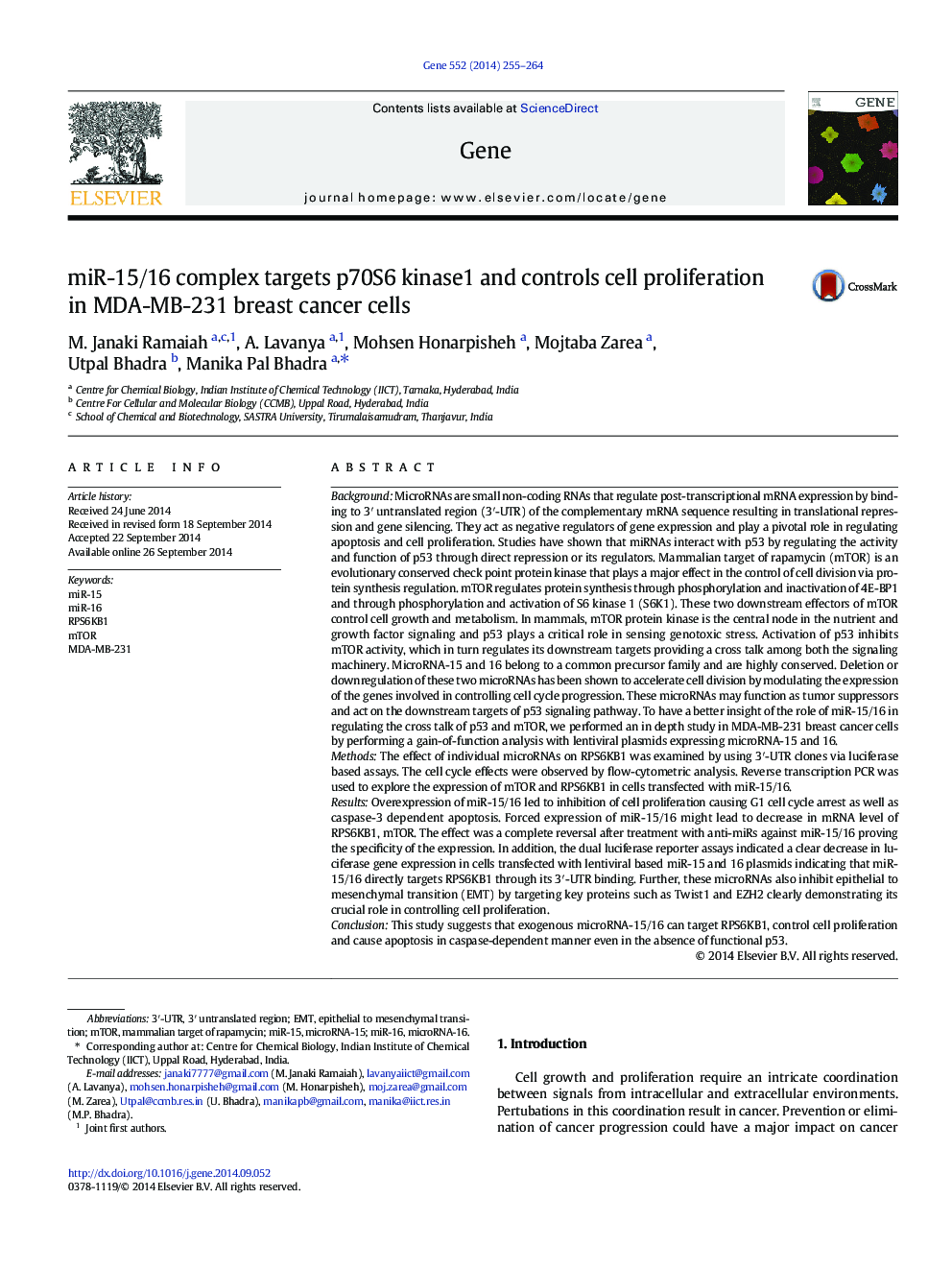| کد مقاله | کد نشریه | سال انتشار | مقاله انگلیسی | نسخه تمام متن |
|---|---|---|---|---|
| 2816104 | 1159915 | 2014 | 10 صفحه PDF | دانلود رایگان |

• Overexpression of miR-15/16 leads to decrease in mRNA levels of RPS6KB1 & mTOR.
• Loss- and gain-of-function studies of p53 confirmed the role of p53 in regulating expression of miR-15 and miR-16.
• miR-15/16 directly targets RPS6KB1 through binding to its 3′-UTR.
• miR-15/16 regulates the expression of cell cycle and tumor suppressor genes.
• miR-15/16 inhibits EMT gene expression and causes apoptosis in MDA-MB-231 cells.
BackgroundMicroRNAs are small non-coding RNAs that regulate post-transcriptional mRNA expression by binding to 3′ untranslated region (3′-UTR) of the complementary mRNA sequence resulting in translational repression and gene silencing. They act as negative regulators of gene expression and play a pivotal role in regulating apoptosis and cell proliferation. Studies have shown that miRNAs interact with p53 by regulating the activity and function of p53 through direct repression or its regulators. Mammalian target of rapamycin (mTOR) is an evolutionary conserved check point protein kinase that plays a major effect in the control of cell division via protein synthesis regulation. mTOR regulates protein synthesis through phosphorylation and inactivation of 4E-BP1 and through phosphorylation and activation of S6 kinase 1 (S6K1). These two downstream effectors of mTOR control cell growth and metabolism. In mammals, mTOR protein kinase is the central node in the nutrient and growth factor signaling and p53 plays a critical role in sensing genotoxic stress. Activation of p53 inhibits mTOR activity, which in turn regulates its downstream targets providing a cross talk among both the signaling machinery. MicroRNA-15 and 16 belong to a common precursor family and are highly conserved. Deletion or downregulation of these two microRNAs has been shown to accelerate cell division by modulating the expression of the genes involved in controlling cell cycle progression. These microRNAs may function as tumor suppressors and act on the downstream targets of p53 signaling pathway. To have a better insight of the role of miR-15/16 in regulating the cross talk of p53 and mTOR, we performed an in depth study in MDA-MB-231 breast cancer cells by performing a gain-of-function analysis with lentiviral plasmids expressing microRNA-15 and 16.MethodsThe effect of individual microRNAs on RPS6KB1 was examined by using 3′-UTR clones via luciferase based assays. The cell cycle effects were observed by flow-cytometric analysis. Reverse transcription PCR was used to explore the expression of mTOR and RPS6KB1 in cells transfected with miR-15/16.ResultsOverexpression of miR-15/16 led to inhibition of cell proliferation causing G1 cell cycle arrest as well as caspase-3 dependent apoptosis. Forced expression of miR-15/16 might lead to decrease in mRNA level of RPS6KB1, mTOR. The effect was a complete reversal after treatment with anti-miRs against miR-15/16 proving the specificity of the expression. In addition, the dual luciferase reporter assays indicated a clear decrease in luciferase gene expression in cells transfected with lentiviral based miR-15 and 16 plasmids indicating that miR-15/16 directly targets RPS6KB1 through its 3′-UTR binding. Further, these microRNAs also inhibit epithelial to mesenchymal transition (EMT) by targeting key proteins such as Twist1 and EZH2 clearly demonstrating its crucial role in controlling cell proliferation.ConclusionThis study suggests that exogenous microRNA-15/16 can target RPS6KB1, control cell proliferation and cause apoptosis in caspase-dependent manner even in the absence of functional p53.
Journal: Gene - Volume 552, Issue 2, 1 December 2014, Pages 255–264